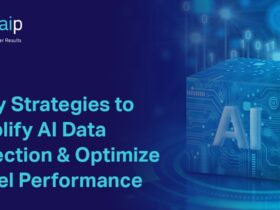A decade ago, developing Artificial Intelligence (AI) was something only big companies and well-funded research institutions could afford. The necessary hardware, software, and data storage costs were very high. But things have changed a lot since then. It all started in 2012 with AlexNet, a deep learning model that showed the true potential of neural networks. This was a game-changer. Then, in 2015, Google released TensorFlow, a powerful tool that made advanced machine learning libraries available to the public. This move was vital in reducing development costs and encouraging innovation.
The momentum continued in 2017 with the introduction of transformer models like BERT and GPT, which revolutionized natural language processing. These models made AI tasks more efficient and cost-effective. By 2020, OpenAI’s GPT-3 set new standards for AI capabilities, highlighting the high costs of training such large models. For example, training a cutting-edge AI model like OpenAI’s GPT-3 in 2020 could cost around 4.6 million dollars, making advanced AI out of reach for most organizations.
By 2023, further advancements, such as more efficient algorithms and specialized hardware, such as NVIDIA’s A100 GPUs, had continued to lower the costs of AI training and deployment. These steady cost reductions have triggered an AI price war, making advanced AI technologies more accessible to a wider range of industries.
Key Players in the AI Price War
The AI price war involves major tech giants and smaller startups, each pivotal in reducing costs and making AI more accessible. Companies like Google, Microsoft, and Amazon are at the forefront, using their vast resources to innovate and cut costs. Google has made significant steps with technologies like Tensor Processing Units (TPUs) and the TensorFlow framework, significantly reducing the cost of AI operations. These tools allow more people and companies to use advanced AI without incurring massive expenses.
Similarly, Microsoft offers Azure AI services that are scalable and affordable, helping companies of all sizes integrate AI into their operations. This has levelled the playing field, allowing small businesses to access previously exclusive technologies to large corporations. Likewise, with its AWS offerings, including SageMaker, Amazon simplifies the process of building and deploying AI models, allowing businesses to start using AI quickly and with minimal hassle.
Startups and smaller companies play an essential role in the AI price war. They introduce innovative and cost-effective AI solutions, challenging the dominance of more giant corporations and driving the industry forward. Many of these smaller players utilize open-source tools, which help reduce their development costs and encourage more competition in the market.
The open-source community is essential in this context, offering free access to powerful AI tools like PyTorch and Keras. Additionally, open-source datasets such as ImageNet and Common Crawl are invaluable resources developers use to build AI models without significant investments.
Large companies, startups, and open-source contributors are lowering AI costs and making the technology more accessible to businesses and individuals worldwide. This competitive environment lowers prices and promotes innovation, continually pushing the boundaries of what AI can achieve.
Technological Advancements Driving Cost Reductions
Advancements in hardware and software have been pivotal in reducing AI costs. Specialized processors like GPUs and TPUs, designed for intensive AI computations, have outperformed traditional CPUs, reducing both development time and costs. Software improvements have also contributed to cost efficiency. Techniques like model pruning, quantization, and knowledge distillation create smaller, more efficient models that require less power and storage, enabling deployment across various devices.
Cloud computing platforms like AWS, Google Cloud, and Microsoft Azure provide scalable, cost-effective AI services on a pay-as-you-go model, reducing the need for hefty upfront infrastructure investments. Edge computing further lowers costs by processing data closer to its source, reducing data transfer expenses and enabling real-time processing for applications like autonomous vehicles and industrial automation. These technological advancements are expanding AI’s reach, making it more affordable and accessible.
Economies of scale and investment trends have also significantly influenced AI pricing. As AI adoption increases, development and deployment costs decrease because fixed costs are spread over larger units. Venture capital investments in AI startups have also played a key role in reducing costs. These investments enable startups to scale quickly and innovate, bringing cost-effective AI solutions to market. The competitive funding environment encourages startups to cut costs and improve efficiency. This environment supports continuous innovation and cost reduction, benefiting businesses and consumers.
Market Responses and Democratization of AI
With declining AI costs, consumers and businesses have rapidly adopted these technologies. Enterprises use affordable AI solutions to enhance customer service, optimize operations, and create new products. AI-powered chatbots and virtual assistants have become common in customer service, providing efficient support. Reduced AI costs have also significantly impacted globally, particularly in emerging markets, allowing businesses to compete globally and increase economic growth.
No-code and low-code platforms and AutoML tools are further democratizing AI. These tools simplify the development process, allowing users with minimal programming skills to create AI models and applications, reducing development time and costs. AutoML tools automate complex tasks like data preprocessing and feature selection, making AI accessible even to non-experts. This broadens AI’s impact across various sectors and allows businesses of all sizes to benefit from AI capabilities.
AI Cost Reduction Impacts on Industry
Reducing AI costs results in widespread adoption and innovation across industries, transforming businesses’ operations. AI enhances diagnostics and treatments in healthcare, with tools like IBM Watson Health and Zebra Medical Vision providing better access to advanced care.
Likewise, AI personalizes customer experiences and optimizes retail operations, with companies like Amazon and Walmart leading the way. Smaller retailers are also adopting these technologies, increasing competition and promoting innovation. In finance, AI improves fraud detection, risk management, and customer service, with banks and companies like Ant Financial using AI to assess creditworthiness and expand access to financial services. These examples show how reduced AI costs promote innovation and expand market opportunities across diverse sectors.
Challenges and Risks Associated with Lower AI Costs
While lower AI costs have facilitated broader adoption, they also bring hidden expenses and risks. Data privacy and security are significant concerns, as AI systems often handle sensitive information. Ensuring compliance with regulations and securing these systems can increase project costs. Additionally, AI models require ongoing updates and monitoring to remain accurate and effective, which can be costly for businesses without specialized AI teams.
The desire to cut costs could compromise the quality of AI solutions. High-quality AI development requires large, diverse datasets and significant computational resources. Cutting costs might lead to less accurate models, affecting reliability and user trust. Moreover, as AI becomes more accessible, the risk of misuse increases, such as creating deepfakes or automating cyberattacks. AI can also increase biases if trained on biased data, leading to unfair outcomes. Addressing these challenges requires careful investment in data quality, model maintenance, and strong ethical practices to ensure responsible AI use.
The Bottom Line
As AI becomes more affordable, its impact becomes more evident across various industries. Lower costs make advanced AI tools accessible to businesses of all sizes, driving innovation and competition on a global scale. AI-powered solutions are now a part of everyday business operations, enhancing efficiencies and creating new growth opportunities.
However, the rapid adoption of AI also brings challenges that must be addressed. Lower costs can hide data privacy, security, and ongoing maintenance expenses. Ensuring compliance and protecting sensitive data adds to the overall costs of AI projects. There is also a risk of compromising AI quality if cost-cutting measures affect data quality or computational resources, leading to flawed models.
Stakeholders must collaborate to balance AI’s benefits with its risks. Investing in high-quality data, robust testing, and continuous improvement will maintain AI’s integrity and build trust. Promoting transparency and fairness ensures AI is used ethically, enriching business operations and enhancing the human experience.













